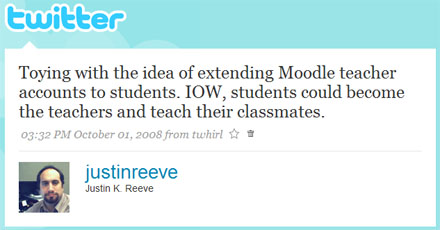Justin Reeve
This user hasn't shared any profile information
Posts by Justin Reeve
Letter Regarding the Digital Divide
0As an exercise in my EDTECH 501 class, I wrote a fictional letter to my city’s mayor about the issue of digital inequality. My proposals might be a little overly ambitious, but this was a good exercise nonetheless.
I did actually have a minor familiarity with the digital divide and digital inequality. Digital inequality is a problem with many of our district’s students, since our district almost exclusively covers suburban and rural areas. In many of the outer areas, high-speed Internet access isn’t even available, and households are still limited to dial-up.
I believe it’s important for teachers to be aware of this issue, and be able to adapt their lessons and homework to the students who may not be able to access computer-based content at home. In our district, many of our teachers make use of online classrooms, blogs, videos through our media sharing site, and more. Our state, like many others, requires that up-to-date records of student grades and attendance be provided to parents via the web. We invest a lot of effort in making sure parents have ready access to their students’ information, even though many of them simply will never log in because they don’t have the means to.
On the other hand, there are people who insist that digital inequality isn’t really much of an issue anymore (see, e.g. http://www.edweek.org/dd/articles/2007/09/12/02divide.h01.html). Internet coverage is expanding, ISP prices are dropping, smart phones are becoming more and more advanced and connecting to the Internet faster, open wi-fi hotspots are popping up all over the place, and many businesses and fast food restaurants provide free wireless access. Some schools (not Weber yet) are even providing 1:1 programs which allow students to take laptops home. Is it possible that one day digital inequality will be a complete nonissue, much like the digital divide is now? I certainly think so.
I’m the web manager of Weber School District, and I’m writing in regards to a problem in the community, and asking for your assistance in endorsing three measures to address it. In our schools we work hard to provide Internet access to students regardless of gender, ethnicity, disability, or family social status. Every student in the school has equal access to a safely-filtered Internet in our media centers, computer labs, and in many of our classrooms. At one point, the “digital divide” or a disparity of Internet access in different schools was a concern, but now, every school in our district has high-speed Internet access. However, the instant they return to their homes, the situation changes.
A “digital inequality” still exists in our community’s homes. In a nationwide study, it was found that while 78% of white students have Internet access at home, only 46% of African-American and 48% of Latinos had the same benefit. 68% of non-disabled students had Internet access at home, compared to 55% of disabled students. Since the only option for many disabled students to participate in education is through home schooling or virtual schools, the importance of having a computer at home is becoming increasingly necessary.
For Spanish-only speaking families, only 32% of kids had home Internet access, compared with 69% of kids with English-speaking parents. Parental income plays a part, too. 88% of kids with parents who earned more than $75,000 a year had Internet access at home, compared to 37% of kids with parents earning under $20,000 a year.
The majority of our city’s children attend schools within Weber School District, and the district places a heavy focus on Internet technologies. Our online course system, which supplements in-class learning, is growing by leaps and bounds. Many of our district’s teachers now expect their students to access online course material from home. Teachers also share assignments, classroom updates, and news on their blogs, which is invaluable for parents. However, this is all useless if the family has no computer at home. This creates a significant educational disadvantage for students in underprivileged families.
Fortunately, there are other means to obtain computer access, such as the local library. This is a great service to the community. However, every time I visit the library, the computer lab is always full. It doesn’t seem to matter what time of day, either. There are sometimes even people waiting in line to use a computer.
I am suggesting the following measures be implemented:
- I strongly encourage that a second computer lab be built in the Weber County Library, Roy Branch. Library hours should also be extended, if possible, so members of the community have a larger time window in which to access a computer and the Internet.
- The city should implement a volunteer-based computer recovery program to obtain discarded, unused, and broken computers and repair them for reuse. I’m familiar with a great many technology professionals in the area who have expressed their interest to me in donating their spare time to this type of project. Hundreds of computers are thrown away every day, when they could be salvaged and refurbished. An assortment of free, open source software would then be installed on the machines, including a Linux operating system, the OpenOffice word processing suite (which is comparable to Microsoft Office), a web browser, an email client, and free educational games for kids. All this software is available at absolutely zero cost. These recycled computers would then be donated to underprivileged families in our community. We would also provide free classes at the local library once a month. The classes would train people on how to use the donated computer systems’ software, since I believe training should accompany any technological deployment.
- Providing computers is only one step in addressing digital inequality, and does not necessarily guarantee Internet access will be available to low-income or underprivileged families. For this reason, I propose a feasibility study be conducted investigating the possibility of providing Roy with a free, open wireless Internet service. This has been accomplished in large cities such as Chicago, San Francisco, Houston, and St. Louis, and in numerous smaller cities and towns across the U.S.
I believe these measures will help narrow the gap caused by Digital Inequality in our community, and help ensure that our city’s population will be afforded equal access to both computers and the Internet. I appreciate your consideration in this matter.
Sincerely,
Justin K. Reeve
References
Barzilai-Nahon, K. (2006). Gaps and bits: Conceptualizing measurements for digital divide/s. The Information Society, 22(5), 269-278. (PDF file)
Computer and Internet Use by Students in 2003. (2006, September 5). Retrieved September 21, 2008, from http://nces.ed.gov/pubsearch/pubsinfo.asp?pubid=2006065.
Cooper, M. (2004). Expanding the digital divide and falling behind in broadband. Consumer Federation of America and Consumers Union, October. Retrieved from http://www.consumerfed.org/pdfs/digitaldivide.pdf.
DiMaggio, P., & Hargittai, E. (2001). From the ‘digital divide’ to ‘digital inequality’: Studying Internet use as penetration increases. Princeton University Center for Arts and Cultural Policy Studies, Working Paper Series, number 15. Retrieved from http://www.princeton.edu/~artspol/workpap/WP15%20-%20DiMaggio+Hargittai.pdf.
DiMaggio, P., Hargittai, E., Celeste, C., & Shafer, S. (2004). From unequal access to differentiated use: A literature review and agenda for research on digital inequality. Social Inequality, 355-400. Retrieved from http://www.eszter.com/research/pubs/dimaggio-etal-digitalinequality.pdf.
Hargittai, E. (2003). The digital divide and what to do about it. New Economy Handbook, 821-839. Retrieved from http://www.eszter.com/research/pubs/hargittai-digitaldivide.pdf.
McConnaughey, J., Nila, C. A., & Sloan, T. (1995). Falling through the net: A survey of the “have nots” in rural and urban America. National Telecommunications and Information Administration. July. Retrieved from http://www.ntia.doc.gov/ntiahome/fallingthru.html.
Trotter, A. (2007, September 12). Digital Divide 2.0: Ed. tech. experts tackle the question: Is there still a technological divide between the haves and have-nots? Digital Directions, September 2007. Retrieved from http://www.edweek.org/dd/articles/2007/09/12/02divide.h01.html.
My First Memory of an Educational Technology: BASIC on an Apple II computer
0 My first memory of an educational technology was using the BASIC programming language in first grade. There were only a few Apple IIe machines, and the nearest ones were in the next classroom, so the teacher sent us over in groups of 5 or 6 at a time to work on the project. I even remember the first program my teacher had the students create:
My first memory of an educational technology was using the BASIC programming language in first grade. There were only a few Apple IIe machines, and the nearest ones were in the next classroom, so the teacher sent us over in groups of 5 or 6 at a time to work on the project. I even remember the first program my teacher had the students create:
10 PRINT “LITTLE BO-PEEP LOST HER SHEEP”
20 PRINT “BOO-HOO”
30 GOTO 20
The result was seeing the screen filled with endless “BOO-HOOs” line after line — the “LITTLE BO-PEEP” line was only noticed with a quick eye — and a group of gasping, excited 7 year-olds.
That was my first exposure to an educational technology, and my first introduction to programming. I don’t recall any instruction in BASIC after that, but not long after this exercise, my parents bought me an Atari 1200XL and a BASIC programming manual. I started learning more about how programs follow logical patterns, how algorithms can be used to achieve desired results, how to perform simple mathematical calculations, and even how to create the most simple games. What was extremely helpful were the issues of 3-2-1 Contact magazine I received which contained BASIC programs other readers had written. Whenever a new issue came in the mail, I would boot up the computer and feverishly copy the lines of code out of the magazine, anxious to see the results.
It’s kind of funny that I ended up becoming a programmer by profession. It makes me wonder if my career would have turned out differently if my teacher had decided not to have her students type up those little three lines of code 23 years ago.
References
Featuring Links on Your Site
0The school district’s Links of the Day was created by importing bookmarks from social bookmarking tool Delicious. I wrote a script using the PHP PEAR library. It’s an extension of the PHP scripting language — which is pretty popular for web sites — that includes a way to connect to Delicious as one of its features. The script is scheduled to run every night, and automatically imports my newest bookmarks from Delicious, and adds them to a MySQL database. From there, I simply add the date I want it to appear, in my MySQL client, and another page (separate from the scheduled script) loads the data that was imported and shows all the bookmarks for the current day. When I get the chance, I’m going to add pagination features so all the links don’t appear on the same page, as well as the ability to search by tag and description.
I realize all that is probably more technical than anyone cares about or is necessarily capable of doing. Most teachers aren’t school webmasters, and just want a simple way to share links on their web site or blog. There are alternatives. Most sites and blogs have some way to display RSS feeds. If you use the feed of your Delicious bookmarks, you could stick your bookmarks on your site. This method doesn’t exactly provide an automatic “Link of the Day” but you can add a “Featured Links” to your site:
-
Grab your Delicious account’s RSS feed: http://feeds.delicious.com/v2/rss/{username} (replace {username} with your Delicious username).
-
If you’d rather pull links in from a Delicious group, from a specific tag, etc. see this page for other feed options: http://delicious.com/help/json
-
Stick this on, e.g., your blog sidebar as an RSS widget.
If your site doesn’t have native RSS functionality, or is just plain HTML code that gets uploaded and updated, you can embed a third-party widget like this one: http://www.widgetbox.com/widget/rss Grab the embed codes and just stick them on your site where you want it to show up. Links will now appear on your site as soon as you add them to Delicious. It’s not exactly a “Link of the Day” but at least you can share links with others in a simple way on your own site.
If you would rather have a “daily” link, you could do the following to get some semblance of this functionality. This method involves using a Twitter account, too:
-
Create an account on TwitterFeed.
-
Click “Create New Feed” and add your Delicious RSS feed as the new feed.
-
Set the new feed contents to retrieve only every 24 hours, and only 1 item at a time.
-
Connect this to your Twitter account in the “Configure Your Publishing Services” option.
-
Use http://www.widgetbox.com/widget/rss or another RSS widget to embed this on your site.
Now only 1 new link per day will show on your site. Problem with this, at least 1 new link needs to be bookmarked per day for this to work. If you’re pulling these links from a large Ed Tech-themed Delicious group, where 100+ people are adding links all the time, it probably wouldn’t be a problem, though of course then you don’t have control over what shows up.
Google Squared
3Google recently launched their Google Squared service. In their own words, “Google Squared takes a category and creates a starter ‘square’ of information, automatically fetching and organizing facts from across the web.”
Do I see myself using Google Squared very often? Probably not. But can it be useful in some circumstances? Definitely. It requires a different way of approaching how you’re going to search.
Usually when I search for something in Google, I just enter a list of the most relevant keywords, with the goal of obtaining very specific results. With Google Squared, though, you don’t want specific results. You want a broad range of results, organized into neat categories. Google Squared is more geared toward those who want to compare information, rather than obtain specific information.
As an example, I typed “Big Band Musicians” into Google Squared, and it came up with this spreadsheet:
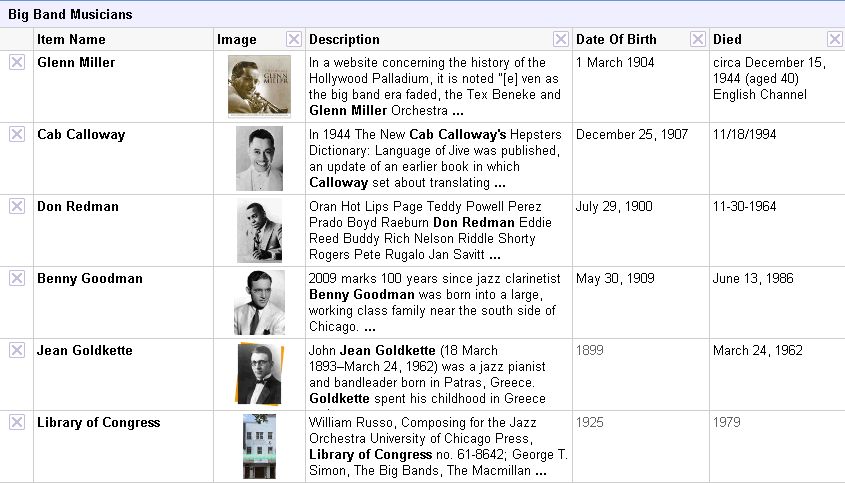
With minimal effort, a nice table of data is created for us, with information like dates of birth and death, short bios, and photos of the musicians. You can see that some faulty information may creep in, like the “Library of Congress” on the last row. These can be easily and quickly removed from the list by just clicking the X next to the row. Or if you click on some individual cells, you may get alternative text that makes more sense in the context, and it’s just a simple click to change how the erroneous fields are populated.
The real power of Google Squared comes in the ability to add your own columns. So let’s say I want to get some more information on each musician, like:
- Which instrument each musician played.
- The name of their spouse.
- Some of their famous works.
- How they died.
I simply add columns like “Instrument”, “Married”, “Famous For”, and “Cause of Death.” The columns are auto-populated with data, and the result is this modified spreadsheet:
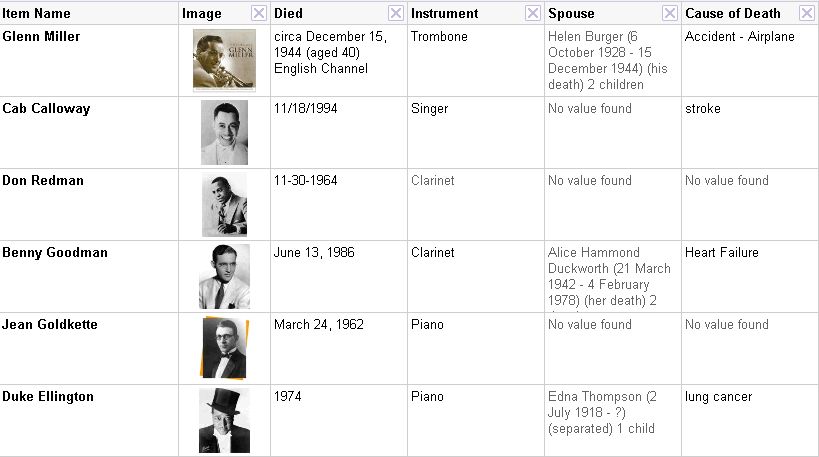
This can be a pretty powerful tool, if you have a need to organize your search results together. Perhaps you’re looking for ski resorts, or local restaurants, and need a way to compare them to make a decision. Or maybe one of your students is writing a paper on insects, or Greek philosophers. A simple Google Squared search can make the collection of tabular data much simpler. Granted, a student will want to fine-tune the data that’s provided if they’re going to use this as a visual aid in a research paper, but it’s a very quick and easy way to jumpstart research on a broad topic. Not to mention Google Squared is certainly much more organized than the straight-down list Google traditionally provides.
Some Simple MySQL Queries for Moodle
4The Moodle logs contain some great data on user activity. Awhile ago, I put a page detailing some statistics on WSD Online, our own Moodle server. You can find that page here: http://www.weber.k12.ut.us/index.php?page=moodle-statistics
Here’s a few MySQL queries you can use on your own Moodle server to get some statistics on the most popular activities, the most active users, and the most active courses. These have been tested with Moodle 1.9. I’m not a MySQL master, so they could probably use some further optimization, but overall they should work well enough:
Find the most popular activities:
SELECT COUNT(l.id) hits, module
FROM mdl_log l
WHERE module != 'login' AND module != 'course' AND module != 'role'
GROUP BY module
ORDER BY hits DESC
Find the most active users over the past 7 days (change the “604800” to the number of the appropriate number of seconds if you want to adjust this interval):
SELECT COUNT(l.id) hits, l.userid, u.username, u.firstname, u.lastname
FROM mdl_log l INNER JOIN mdl_user u ON l.userid = u.id
WHERE l.time > UNIX_TIMESTAMP(NOW()) - 604800
GROUP BY l.userid
ORDER BY hits DESC
Find the most active courses:
SELECT COUNT(l.id) hits, l.course courseId, c.fullname coursename
FROM mdl_log l INNER JOIN mdl_course c ON l.course = c.id
GROUP BY courseId
ORDER BY hits DESC
(You may need to change the second line to FROM mdl_log l INNER JOIN mdl_course c ON l.course = c.id AND c.id != ‘1’ to omit home page hits)
Turning Students Into Teachers with Moodle
8I’ve noticed a few differences in how our teachers and students use Moodle. The details may vary, but in general a teacher will log in, maybe upload a PowerPoint document, and if they’re adventurous they’ll set up an online quiz, and possibly a forum.
A student, on the other hand, logs in, and explores everything. One of the first things they’ll notice is their Profile page. They’ll edit their profile, upload a photo of themselves, and may even get creative and embed a cool Flash widget they like. Then they’ll pop into the class forum and post a message. They will return to this forum a few times throughout the day to continue talking to their classmates. They will then download the teacher’s course material, study it, and take the teacher’s quiz that’s been set up. They may then return to the forum to see if anyone responded to their messages, and maybe post another message to someone else, before uploading their daily homework assignment.
 See a pattern here? Students are the power users. The technology is familiar to our “digital natives,” and they enjoy using it. Some of our students have even panicked when the technology wasn’t available. Once our Moodle server went down for a reboot, and was offline only about 2 minutes when I received an IM from a teacher. She said the students were freaking out and asking “When will Moodle be back up?”
See a pattern here? Students are the power users. The technology is familiar to our “digital natives,” and they enjoy using it. Some of our students have even panicked when the technology wasn’t available. Once our Moodle server went down for a reboot, and was offline only about 2 minutes when I received an IM from a teacher. She said the students were freaking out and asking “When will Moodle be back up?”
So I had a thought the other day:
Teachers can manage classes in Moodle, but why not students? People often learn best when they teach, and it seems like we’re only targeting half our potential audience here. We could turn the students into teachers, and let them teach their classmates. It would be a great way to create effective learners.
A teacher could use this as a classroom activity. They could assign students to “teach” a particular topic they’re studying in class, and the student could create video presentations, quizzes, wikis, and other course material in their own Moodle course. They will become better learners through teaching, and we will be preparing them for college by introducing them to their online classroom space.
Not Just for In-Class
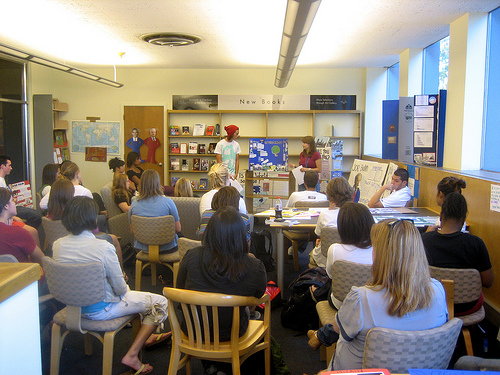 But online student-teaching could extend beyond the classroom as well. Under the sponsorship and mentoring of a teacher, a student could teach about any subject that interests them, whether it be athletics, books, auto repair, video games, woodworking, painting, animation, music, and more. Imagine a whole network of students teaching about a diverse range of topics. Other students could browse the available courses their peers are instructing, enroll, and contribute to a system where student interests and knowledge are shared in a constructive, educational manner. Moodle could become the focal point of a vibrant student learning network.
But online student-teaching could extend beyond the classroom as well. Under the sponsorship and mentoring of a teacher, a student could teach about any subject that interests them, whether it be athletics, books, auto repair, video games, woodworking, painting, animation, music, and more. Imagine a whole network of students teaching about a diverse range of topics. Other students could browse the available courses their peers are instructing, enroll, and contribute to a system where student interests and knowledge are shared in a constructive, educational manner. Moodle could become the focal point of a vibrant student learning network.
A rewards system may provide an added incentive to this “Young Teachers” program. Example: for every student that signs up for a course, the student-teacher earns points. If enrollees pass the course by taking an exam, the student-teacher earns even more points. Those who pass a student-made course could earn “attendee points” and receive certificates for passing. At the end of the year, we could give out prizes for those who’ve earned the most points, or hold an awards ceremony to recognize the best student-teachers.
With the right motivation, we would have no problem finding students interested in teaching their own classes.
Is This Really “Educational?”
The very nature of having students teaching courses is educational, because we’d be placing them in managerial roles as they organize their online classrooms. They would set up their course how they want, determine the best method of teaching and presenting the material, and create quizzes to make sure the other students understand what they are teaching. They could even organize activities through their online classroom. For example, a student teaching a class on theatre arts could set up a date to have everyone attend a local play. A student teaching a class on poetry could set up an online chat session with an English professor his family knows. There are numerous possibilities here.
At the same time, some questions need to be asked. Since this may be extracurricular for students, do we need to worry about keeping all student-taught courses within the state core curriculum? Also, it might not really be considered “educational” to let students teach a class on, e.g., video games, and just discuss strategies for Halo 3, when they could be teaching concepts of video game design and providing helpful tutorials and tools for independent game development. Clear goals should be outlined and standards set forth, so the teacher mentors can guide the students toward education-appropriate courses.
Benefits
- Students would become more actively involved in the educational process, both on the receiving and giving end.
- We would be preparing students for college by promoting self-directed learning, and introducing them to the online class environment.
- Studies have shown that online learning opportunities can encourage even the normally reticent students to participate in class.
- The beginnings of a student learning network would be created.
- Students would develop organizational leadership skills.
- Students would earn the recognition of their teachers, parents, and peers.
- Students would find it motivating and empowering to maintain their own online classroom about a subject that interests them.
- Students would have a valuable portfolio of their work.
- Parents could visit their student’s course and follow the progress.
Teacher Mentors
Each school could have one or two teacher mentors for these student-created courses. They would be responsible for the following:
- Hearing and approving student course requests.
- Creating the student course in Moodle.
- Making sure students understand the rules for their course, such as appropriate behavior (no offensive material or language) and resources they can use, breadth requirements for the “passing” exam, etc.
- Being available for questions about appropriate course material and helping students with extracurricular activity planning if necessary.
- Periodically checking up on the students’ courses.
BrainBlast 2008: Survey Results and Musings
8 Last month, in the first week of August, the Weber School District Technical Services Department hosted the second annual BrainBlast conference. BrainBlast is a time of year when we techs get to feel like rock stars, and the whole thing was a resounding success. The keynote speakers were excellent, the techs were responsive, Vinnie’s antics were hilarious, the vast majority of the teachers I spoke to felt they were learning a lot and that the conference was worthwhile, and we amazingly managed to pull off an impromptu musical presentation on the last day for the secondary teachers.
Last month, in the first week of August, the Weber School District Technical Services Department hosted the second annual BrainBlast conference. BrainBlast is a time of year when we techs get to feel like rock stars, and the whole thing was a resounding success. The keynote speakers were excellent, the techs were responsive, Vinnie’s antics were hilarious, the vast majority of the teachers I spoke to felt they were learning a lot and that the conference was worthwhile, and we amazingly managed to pull off an impromptu musical presentation on the last day for the secondary teachers.
The feedback we received from the teachers we surveyed was generally quite positive. We asked everyone to answer some general questions about the conference, followed by some specific questions about each class. I’ve processed the results we received and came up with some average statistics. All the ratings below are on a scale of 1 to 5, with 5 being the highest.
Conference Ratings
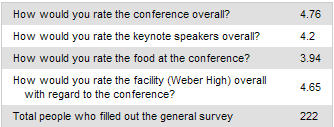
Just the fact that the average ranking for the conference overall, out of 222 survey-takers, was a high 4.76 is especially pleasing. We had some great keynote speakers: Kevin Eubank, Jim Vanides, and Ken Sardoni. In retrospect, we should have had each keynote speaker ranked separately in the survey, rather than all together. We’ll make sure we do that for next year. The food from Iron Gate Grill wasn’t bad, but nothing to write home about, so I basically agree with the rating there. And the Maintenance Department did a great job getting Weber High ready. Kudos to everyone who helped put everything together.
We offered 19 different classes in all. The following statistics show the most well-received classes:
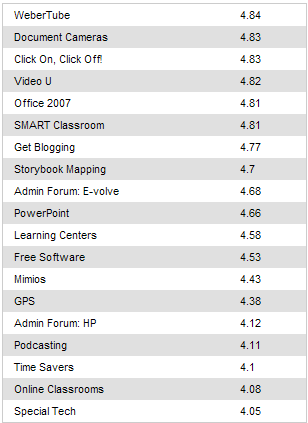
It’s not surprising to see the class on WeberTube, our new media sharing site, at #1. Shawn Potokar debuted this excellent new system at BrainBlast, and it received a great response. This is what teachers have been waiting for. I’ve mentioned this before, but I believe that if we block something that’s useful for educational purposes, we’re obligated to provide an alternative. Due to inappropriate content we must block YouTube, but WeberTube is our answer to that. And in his session, Shawn even showed the attendees how to pull videos off YouTube at home and upload them to WeberTube (see this post by Justin McFarland for a summary of this method). I’ve enjoyed seeing the videos our teachers have uploaded so far this school year.
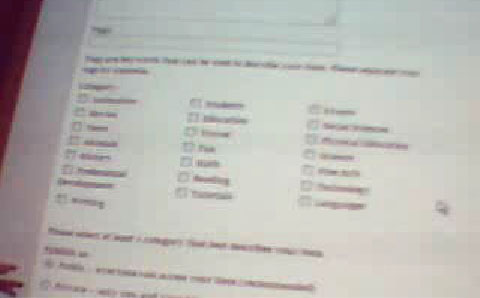 Shawn Potokar also taught the Video U class, the #4 rated class, and showed some basic tips with Windows Movie Maker. Honestly, I wasn’t all that familiar with Movie Maker, but now I regret it. Last July I was assigned the task of creating a 30-minute video compilation for my grandmother’s 90th birthday, and I wrestled with various tools, mostly Adobe Premiere, trying to slap a working product together. Movie Maker would have been so much easier, and I wish Shawn could have shown me the ease and benefits of this product sooner.
Shawn Potokar also taught the Video U class, the #4 rated class, and showed some basic tips with Windows Movie Maker. Honestly, I wasn’t all that familiar with Movie Maker, but now I regret it. Last July I was assigned the task of creating a 30-minute video compilation for my grandmother’s 90th birthday, and I wrestled with various tools, mostly Adobe Premiere, trying to slap a working product together. Movie Maker would have been so much easier, and I wish Shawn could have shown me the ease and benefits of this product sooner.
Jennifer Boyer-Thurgood presented the Document Cameras class, which came in as #2. She was also one of the key organizers of the conference, so if you thought BrainBlast was awesome, you can thank her for it. Document cameras are extremely cool and extremely useful, and it was great to see first-hand how a teacher might use them in the classroom setting. I wish they had them when I was in the public school system. I’m excited to see more and more teachers get them in our district, and hope that they can use them in creative ways.
Bryce Ballif’s clickers class came in #3. I wasn’t really too familiar with the clickers, and this is the best introduction to them I could have hoped for. What a great tool these are for classrooms! Instant responses, statistical feedback…I wish he had more time to go into advanced usages for them, or that more of the attendees could share how the clickers had impacted their teaching.
Moodle Problems
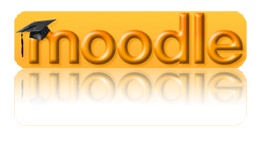 Ryan James introduced WSD Online, our own Moodle system. We launched this at BrainBlast along with WeberTube, but unfortunately it came in second to last. Some teachers commented to me that they were very impressed with WSD Online, and that there was a lot they still could learn there. This itself was the problem and the reason for the low ranking, since it implies how steep the learning curve for Moodle actually is. The steeper the learning curve, the less likely our teachers will use the product.
Ryan James introduced WSD Online, our own Moodle system. We launched this at BrainBlast along with WeberTube, but unfortunately it came in second to last. Some teachers commented to me that they were very impressed with WSD Online, and that there was a lot they still could learn there. This itself was the problem and the reason for the low ranking, since it implies how steep the learning curve for Moodle actually is. The steeper the learning curve, the less likely our teachers will use the product.
A few technical problems with our Moodle system reared their ugly heads during the conference, too. First of all, I didn’t anticipate administrators being in the class, though I should have seen it coming! All our Moodle class data is pulled from our AS400, and since only teachers have classes in the system, administrators were left with no classes to see and nothing to do. As a result, I ended up creating a BrainBlast sandbox after the first “Online Classes” session, so administrators could log in, and at least have a class to create content in.
I’m considering a solution for the administrators, possibly creating a one-click install where they can set up their own unique Moodle system, and do whatever they want with it. In effect, this would give administrators even more flexibility over their courses than teachers currently get, and they could create training courses with those both inside and outside the district, if necessary. (I’ll have to consult with upper management about this one, and hash out a few more ideas.) In the meantime, for those administrators looking for a way to implement online classes, you might want to check out WiZiQ or HotChalk.
Second of all, somehow Two Rivers High School didn’t get their classes added to WSD Online when I upgraded to version 1.9 several weeks ago — I had a few teachers track me down to voice their concerns about this. (My apologies to the Two Rivers teachers.)
Third of all, apparently Moodle spammed a bunch of teachers (sorry!). When we set up the BrainBlast 2008 forum in Moodle, we apparently didn’t turn off the “email every comment everyone posts to everyone who has touched Moodle at any point in time” setting. Why that’s turned on by default, I have no idea!
Live Streams
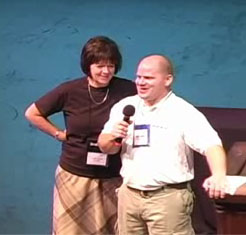 This is the first time we’ve streamed some of the BrainBlast sessions live over the Internet. We even set up a chat room that viewers could visit while the sessions were going on, and though we didn’t take the time to advertise this as well as we could have, since it was mostly experimental, I feel it was very useful. We had a few people come and go, and then some recurring visitors, namely Brent Ludlow from Hooper Elementary, and Mrs. Durff from my Twitter network. I was just streaming off my dinky little webcam, but maybe next year we can install ManyCam or something on the presenters’ desktops and stream better presentations that way. Equipping the presenters with a wireless mic may be a good investment, too.
This is the first time we’ve streamed some of the BrainBlast sessions live over the Internet. We even set up a chat room that viewers could visit while the sessions were going on, and though we didn’t take the time to advertise this as well as we could have, since it was mostly experimental, I feel it was very useful. We had a few people come and go, and then some recurring visitors, namely Brent Ludlow from Hooper Elementary, and Mrs. Durff from my Twitter network. I was just streaming off my dinky little webcam, but maybe next year we can install ManyCam or something on the presenters’ desktops and stream better presentations that way. Equipping the presenters with a wireless mic may be a good investment, too.
Some of the sessions have been uploaded to the BrainBlast WeberTube group. I’ll finish uploading the rest I was able to record soon.
Where Can We Improve?
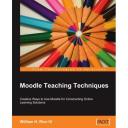 As mentioned earlier, Moodle’s learning curve is too steep for some. Perhaps we should consider having two Moodle classes for next year’s BrainBlast, to cover all possible topics. I personally think William Rice’s Moodle Teaching Techniques would be an excellent resource to pattern any further training we do for Moodle. Another possibility would be to explore a lighter, simpler solution for the teachers who don’t want the vast functionality Moodle offers. More on that in an upcoming post.
As mentioned earlier, Moodle’s learning curve is too steep for some. Perhaps we should consider having two Moodle classes for next year’s BrainBlast, to cover all possible topics. I personally think William Rice’s Moodle Teaching Techniques would be an excellent resource to pattern any further training we do for Moodle. Another possibility would be to explore a lighter, simpler solution for the teachers who don’t want the vast functionality Moodle offers. More on that in an upcoming post.
Nothing is necessarily set in stone, but the current plan for BrainBlast 2009 is to have only two days of training rather than four, and join together the elementary and secondary teachers. In turn, we will increase the number of courses we offer, and expand the usage of the facilities to accommodate all the attendees at once. Frankly, I’m glad that we’re planning on this (I don’t think I can come up with four days worth of jokes about Vinnie again).
It seems that we’ve kind of stuck ourselves into a trend of providing only introductory classes. After spending time in the classes, and following some conversations with our presenters, I realized that the workshop-style subject material didn’t suit all the attendees. Some in the classes were already fairly proficient in Office 2007, PowerPoint, blogging, clickers, and the other technologies we offer in the district, and had to wait for other less-skilled but still eager-to-learn attendees to “catch up.” There wasn’t much room for our presenters to venture into advanced discussions of their topics.
It’s great that we’re offering training to those with such a wide range of skill sets, but at the same time, we need to find a way to group our teachers together based on their skills in particular technologies. It hardly makes sense to teach seasoned bloggers how to set up a blog, use the Dashboard, and write a simple post, when we could be teaching them about great widgets they can use, how to use RSS feeds, the importance of using a plugin like Slimstat to track visitor statistics, and using the blog as a platform to engage the educational community by leaving comments, using pingbacks, trackbacks, and growing your personal learning network.
So I hope that we can do something different this year. In lieu of “elementary” and “secondary” tracks, we could have two different types of classes: “beginner” and “advanced.” I think this would be a good move, as the teachers who want to explore the tools in more depth could do so. This way, those who are already proficient document camera users, SMART Board users, bloggers, Moodlers, Powerpointers, and so on, could learn more advanced tricks without having to wait for their less-proficient (but still eager to learn!) classmates to catch up.
A couple issues come to mind about this approach, though:
- How would we be able to estimate the number of classroom sizes? Could we guarantee full classrooms in all our advanced classes?
- We’d have to very clearly distinguish what an “advanced user” is, so everyone would be on roughly the same page in the class. We don’t want someone who thinks they’re qualified to join the “Advanced Podcasting” class struggling with basic things like recording in Audacity and posting MP3s on their blog. All attendees should be able to jump right into advanced topics without waiting too long for others. Perhaps a simple survey could help registrants determine which track they belong in.
And finally, maybe it’s just just me, but it seems silly that we have teachers going to a technology conference, sitting in a computer lab, and learning about cool web sites, only to write down the web links on paper. Why are we not showing them how to use social bookmarking sites like Delicious or Diigo (especially with the new Diigo accounts for Educators that was just released)? These sites let you store all your bookmarks online, and share them with others in your learning network. They could simply pull up their bookmarks in any class they’re in. Diigo is especially awesome, because it lets you also highlight text on your bookmarked web sites, so you can share specific snippets of text, point to especially relevant passages in long web pages, or even annotate them with your own comments.
I’m already looking forward to BrainBlast 2009. If the trend continues, it will be even more exciting and better than this year’s conference.
Breaking Out of the Shell
0I received an email from one of our teachers a few days ago, expressing concerns over someone outside our district who linked to her blog. This isn’t the first time I’ve received an email like this, so with her permission, I’m posting her email here, followed by my long-winded reply with more information than she probably wanted to know. I hope this provides some clarity to our teachers who may have similar concerns:
Hi – I had something interesting happen on my blog today. I received an e-mail to moderate. The post left was from a student in Alabama that had come across my blog while doing some research for her class. It had me a bit concerned because I thought I had blocked my blog from this? Should I be concerned? She gave me a link to her blog and on her blog she had posted a link back to mine. I am not sure how I feel about that? What should I do? Thanks.
Whether this is good or bad really depends on your point of view. Here’s my two cents. Note that what I say here is just my opinion, and doesn’t represent any official district view, but I hope it provides some perspective.
Keep in mind that the blogs are public, not private. They’ve always been accessible to everyone on the web, and there’s nothing you can really “block” your blog from. Maybe you don’t post links to your blog on all sorts of web sites, but you still don’t have full control over how much it’s publicized. You can password-protect your posts if you want to, but I think that would be missing the point of the blog’s purpose: connectedness and communication. Google indexes your blog so anyone can search it, and we list the latest posts and blog rankings on our district site. We actually do this so people CAN be made more aware of your blog. It’s open to everyone, and it’s a fantastic way to communicate with your students and their parents, and let them communicate with you in turn by leaving comments. Sometimes parents may share your blog with their family and friends, and they in turn may share it with others.
But the blogs can do more than connect you with just your own students and parents. They can also break down the walls of the classroom and connect you to an online learning community, as this student from Alabama demonstrated. I don’t know exactly what this student put in her comment, but she apparently found something very useful on your blog, and liked it enough to not just leave a comment, but link to your blog from her own. That’s a compliment to you. This student’s link will drive more visitors to your blog, and your ranking on the “Visitors per Day” stat will go up.
And if you want to take it further, by following the links your commenters leave, you may find yourself drawn to more sites such as other class blogs, Ning networks, Facebook groups, wikis, Twitter, or wherever educators are gathering on the web. In fact, this is what I’ve found most enjoyable with my own blog, that I can connect with a wide range of people. Most of my visitors aren’t even from within the district; they’re teachers, technology specialists, and school administrators from all over the world. I’ve even been able to meet a few of them face-to-face after connecting with them online. My blog can be a catalyst for stimulating wider conversations and growing my own personal learning network of educators.
There are also teachers out there who are engaged in activities like the Flat Classroom Project – they use wikis and learning networks to synchronize two or more classrooms, and let students from all across the world work with each other on projects. I’ve seen Kindergarten class blogs that have a YackPack button, which lets students and teachers from other classes just click and start talking with the classroom. And here’s some elementary students using Skype to video conference with other students several states away, and doing a collaborative writing project with them in Google Docs, while the teachers and administrators are standing by in amazement. It IS very cool, because it shows you’re not confined to the walls of your classroom anymore.
So my opinion is that this student linking to your blog is a GOOD thing, because it’s just one step to opening you to a larger learning community. And if all this leaves you feeling paranoid, don’t let it! Other teachers are going through many of the same experiences you are, regardless of where they come from, and you can connect with them as well. We want you to have fun with your blog. Be creative with it, and share your classroom experiences, fun activities you do with your students, and more. If other teachers and students outside your class are visiting your blog, that’s just an added bonus.
I also recommend you activate the WP-Slimstat plugin (go to your blog Dashboard, click “Plugins” and then “Activate” next to WP-Slimstat). This will start to gather more detailed statistics on exactly how many people are visiting your blog, what search strings are being used to find your blog, your most popular posts and pages, and so on. If you want some assistance accessing and analyzing all these statistics, let me know.
I hope this helps add a little insight on the wide scope of the blogs. There’s a giant online world out there of online networking and collaboration. Our students are using it already. Perhaps it’s time we start using it, too.
Thanks for the question.
Tracking Earthquakes with Google Earth
3A magnitude 6.1 earthquake this morning off the coast of Vancouver Island was not felt on land, despite being the biggest yet in a swarm of quakes that have hit the region this week. This latest earthquake was reported at 5:37 this morning, centred 152 kilometres west-southwest of Port Hardy and about 10-kilometres below the ocean floor. Calls to businesses in the town so far show no one felt it, and there was no damage and no tsunami. There have been 18 quakes since Tuesday (see map below), all around the Juan de Fuca Ridge. They’ve ranged between magnitude four to five, until today’s quake. (Link)
Maybe this just shows what a geek I am, but after reading this, my first thought right after “Glad no one was hurt!” was “Let’s track this on Google Earth!” If you go to this page on the U.S. Geological Survey’s web site, you can download a KML which will display earthquake data, updated every 5 minutes. A KML is just some geographic data that Google Earth can use, and if you already have Google Earth installed, just downloading it will open it automatically. Once it opens, you will see a series of colored dots, each of which indicate earthquake activity. Corresponding times and magnitudes are available when you move the cursor over the dots.
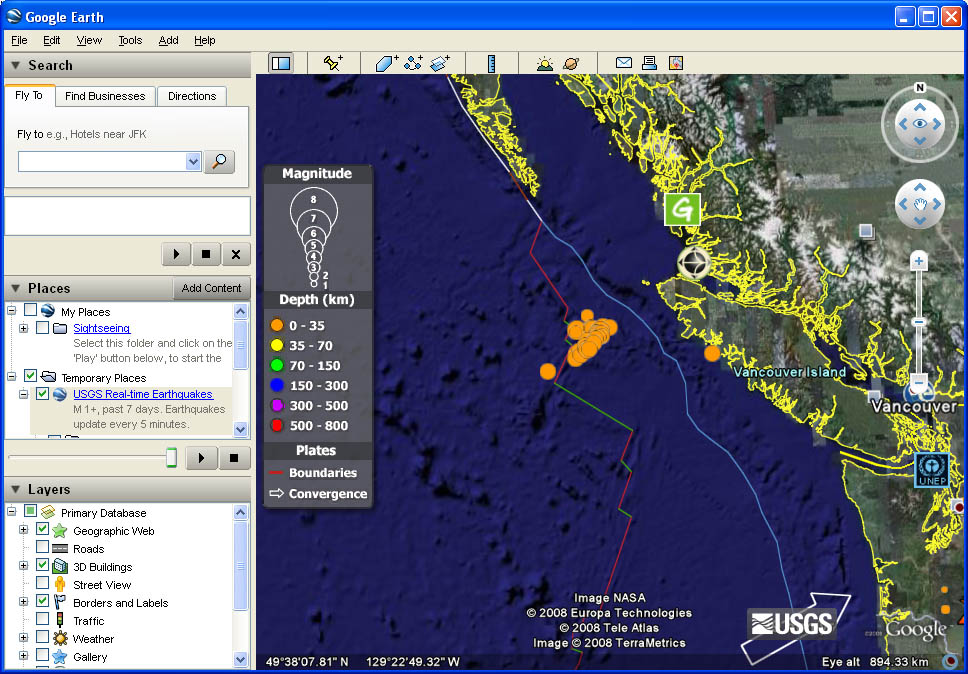
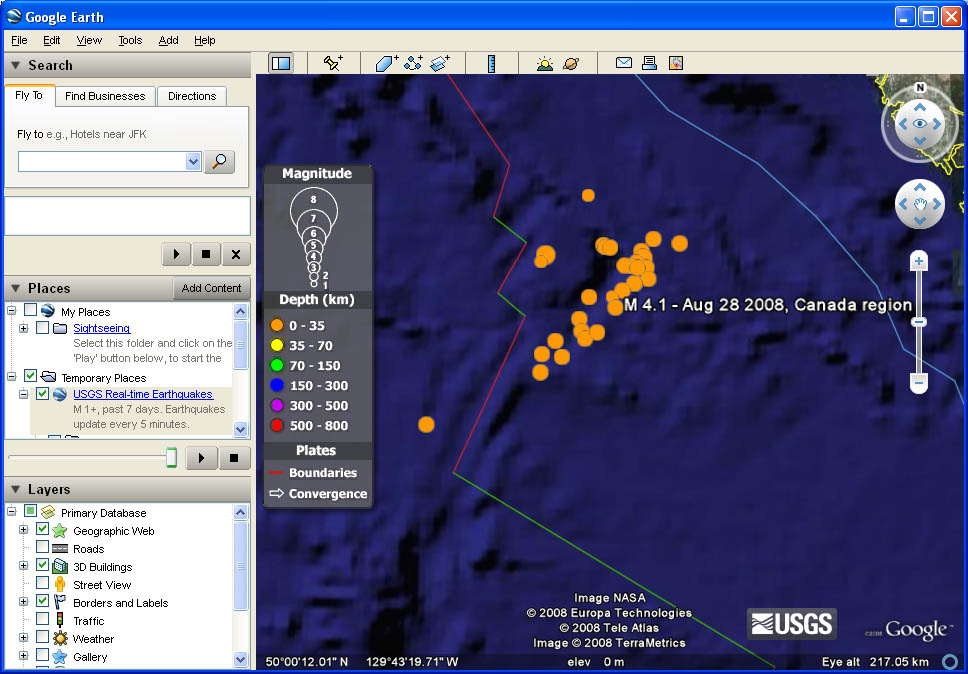
New Features: Weber Blog Statistics and Improved Search
2The blogs have been a fantastic tool for Weber School District. I didn’t expect such rapid growth and usage of them since we launched them in August 2007. If you’re a district employee and haven’t used your blog yet, I encourage you to do so. It’s a great way to share your important thoughts, keep in touch with staff, parents, and students, and receive feedback from them. Just go to this page and click the “Login to Your Blog!” button. Enter your Novell username and password and your blog will be automatically created. We are also offering E-volve training on how to use the blogs, so if you need further assistance, get your school administrator to enroll you in these specialized classes.
As with all Weber School District technologies, please use the blogs responsibly and keep their educational purpose in mind. We’re not concerned if you post some personal pictures of yourself and maybe even your family, so the students and parents can get to know you better. However, don’t use them to post religious content, or sell products for a business, and make sure you keep your language clean. Remember, elementary students have access to and may be reading your blog! If you wish to post class pictures or videos of students on your blog, PLEASE get parental waivers first and work with your school administration on proper procedures to follow through with this. Make sure you don’t at any time post both a student’s photo and name together. If you post a student’s photo, do not include a name. If you post a student’s name, do not include a photo. One or the other, not both.
On to the cool new features. Blog statistics are available for anyone to see! Our employees can see how their blogs rank compared to others. I hope this encourages more active blogging, and well-thought-out content on the posts. I wish to see the blogs transition from being “a place to upload my assignments” to “a place to have conversations with parents, staff, and students.” All statistics are updated daily. Here’s how they work:
Visitors per Day
This is the average number of daily visitors each blog receives, from data collected over the past 30 days. This is kind of a tricky thing to track, and due to the nature of standard web logging techniques, will only be about 98% accurate at best. This tracks unique IP addresses for a given day. So if you have a user who visits your blog from the same computer multiple times during the day, it will only be counted once. If another user hops on to that same computer and visits your blog that day, it will not be counted. If a single user uses two different computers to visit your blog during the day, it will be counted twice. This particular statistic does not omit bots that may come across your site, so all your visitors may not be human (usually just 2 or 3 of your daily visitors will be bots).
Posts per Month
This is the average number of posts each user makes a month, from data collected over the past 90 days. Keep in mind that all posts you make appear on the Latest Blog Posts page, so write relevant content that users will want to read.
Inside Comments
One of the most powerful features of a blog is the ability to leave comments on it. A great way to respond to feedback and encourage discussion is by responding to the people who leave comments on your own blog, and this statistic tracks that. It counts the total number of comments you’ve left on your own blog. The way this is tracked is by the email address which is entered when you leave a comment. Make sure you use your district email, so the blog statistics can recognize you. Also, this doesn’t count unapproved comments. Always make sure you check and approve appropriate comments that are left on your blog, if you are moderating them.
Outside Comments
These are the total number of comments that employees have left on others’ blogs inside the district. Blog-centered conversations would not be possible if it weren’t for people leaving comments on others’ blogs. For now, this statistic only counts employees (not yet students or parents); the reason being that we’re trying to encourage employees across the district to network with each other a little more, and the blogs are a good starting point for this. Again, make sure you use your district email when commenting, so the blog statistics can recognize you. This statistic also doesn’t count unapproved comments.
New Blog Search
Lastly, the Blog Search feature now does more than just return matching names. You can enter any keywords and it will scan the blog posts themselves and return a list of the most relevant results.
